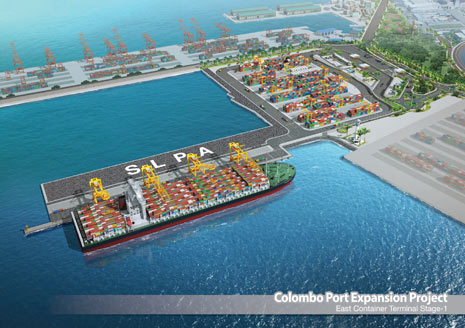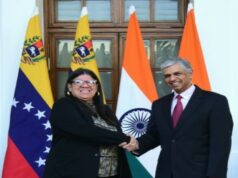COLOMBO: With India planning to develop a transshipment port at Great Nicobar Island in the Bay of Bengal, shipping industry experts and economists have fired warning shots, recommending that the Sri Lankan government assess the risks to Colombo Port and take necessary steps to retain its transshipment market.
On August 10, Indian Prime Minister Narendra Modi announced that India was considering investing around $1.33 billion in a new state-of-the-art transshipment port in Great Nicobar Island. Such a port offers two geographical advantages: proximity to the busy East-West international shipping corridor, and deep-water which can accommodate the latest generation of mega ships.
Rohan Masakorala, CEO, Shippers’ Academy Colombo, which provides shipping advisory services and training, also warned: “I think there will be a threat to Sri Lanka’s ports if India develops the transshipment port but I don’t think it’s going to happen overnight. It’ll take some time, as they have to do feasibility studies. But if they’re doing it in the medium term, there is definitely a challenge for Sri Lanka’s ports because it can affect our catchment areas, which are the east coast of India and Bay of Bengal region”.
“The greatest volume to Sri Lanka comes from the east coast of India, not really from the west coast. Out of the total throughput of transshipment, 80 per cent comes from the Bay of Bengal region. It comes through feeder vessels to Colombo and part of it goes to Singapore and Malaysia and part of it comes to Sri Lanka.”
“Sri Lanka could get majorly affected if they (India) successfully build a deep-draft terminal. It will be kind of a home affair if so, because Indian ports will be feeding the Indian transshipment location if they can develop it.”
Repeating Past Mistakes
Masakorala said Sri Lanka may have missed the proverbial bus to establishing dominance as the main transshipment hub: “This happened to Sri Lanka in the past because of our delayed decision-making, and as a result of people investing in other places. A classic example is the Omani Port of Salalah to the west coast (of India). That port was opened in 1998 with a consortium of five international partners including Maersk Line and the Omani Government. At that time, Sri Lanka was again delaying the development of the Old Harbour and bringing in the private sector to develop; even the South Asia Gateway Terminals (SAGT) was implemented in 1999.”
He said Lankan officials had taken the establishment of the Omani Port lightly and later regretted their care-free attitude, and scrambled to set up the SAGT soon after the Salalah Port had begun operations.
“When Oman developed this port, it had the facility of a deep-draft terminal, (which was) also where Maersk was involved. I recall very well how our people ignored the fact that a portion of business in Colombo would be lost; they said that as there are major weather issues such as cyclones in Oman, the port would not be successful”.
“But today, after 20 years, it has gone to become a 4.1 million TEU (20-foot equivalent unit)-capacity transshipment hub in the Middle East—some of this could have come to Colombo. The TEU capacity in Colombo is seven million after 40 years of operation; Oman reached 4.1 million within a much shorter period.”
“The port mostly attracts cargo from Pakistan and the west coast of India; a part (of the cargo) could have been Sri Lanka’s if we were prudent in developing infrastructure and (establishing) international partnerships. However, only after Oman (Port was established) did we develop a partnership at SAGT.”
“As such, we have experience of not doing the right thing at the right time; losing our share of the market in the Indian subcontinent. If the (port in the) Andaman and Nicobar Islands is developed, as it is not too much of a detour from the main East-West shipping route, and with India having its own cargo base as an added strength, there is a possibility that some of the cargo (from Colombo) would divert to the new port.”
He noted that as a result of Sri Lanka’s nationalistic politics, development of the Colombo Port is adversely affected, where planned foreign investment and international partnerships have been rejected or stopped.
“There is a serious risk (in halting these partnerships) and if we ignore it and delay our development projects and say that our ports can only be handled by the Sri Lanka Ports Authority (SLPA), that is a recipe for disaster.”
He said that all other major ports in the world were operating with international partnerships and consortiums as shipping was “truly a global business”.
“We are competing with the rest of the region. For example, in the United Arab Emirates (UAE), Abu Dhabi is building a massive terminal with the Mediterranean Shipping Company as its biggest partner; even developed and wealthy countries have international partnerships.”
“It’s the same even in India. The Port of Singapore and Dubai Ports (DP) World operate there. Even Singapore has terminal operation agreements with shipping lines. All the countries have adopted that model.”
“In the meantime, Sri Lanka, delaying the development of the East (Container) Terminal (ECT), is actually playing into the hands of the competition.”
Right Thing At The Right Time
He said successive governments’ political interference had delayed the development of the ECT.
“The development of the East (Container) Terminal has already been delayed by six years because of politicking. It should have been running and operational by around 2014/15. We planned to operate the East (Container) Terminal with international partners as bids were called in 2016/17 and four consortiums, including four Sri Lankan companies, had bid for it. But (former) President (Maithripala) Sirisena, after appointing cabinet committees to open up those tenders, just abandoned it, saying: ‘We are not going to allow foreign companies to operate; it’s going to be an SLPA operation.’
“Subsequently however, he went to India and had a chat with their Prime Minister and agreed to open it up to a government-to-government agreement between India, Japan and Sri Lanka.”
Highlighting detriments of the SLPA’s nationalistic approach, Masakorala pointed out that the SLPA unions that had stayed mum during the inception of the SAGT were now crying foul over the development of the ECT with the assistance of a foreign government with a larger share for Sri Lanka.
“But that led to unions taking action demanding that the ECT be done only by the SLPA. These unions remained quiet when the SAGT was done in 1999 with 10 consortiums, with the SLPA having only a 15 per cent share; also in 2013 when CICT (Colombo International Container Terminals) was done with a similar 15 per cent share for the SLPA.”
“But when we are talking about a 51 per cent share for Sri Lanka in the ECT, the unions are making the biggest fuss. What they’re doing is not logical. They are simply damaging the country’s potential of becoming a (maritime transshipment) hub.”
He pointed out that the SLPA wanting to be the sole operator was in fact bringing to a standstill any advancement to the Colombo Port while other nations moved ahead at full throttle.
“The SLPA is talking of looking inwards, saying they should be handling their terminals. However, it is important to note that all the other establishments that came in after the SLPA are operating successful ports around the world.”
“For example, the Philippines is running about 27 terminals worldwide; so does DP World; the Singapore Port Authority handles 40 million containers in Singapore and another 40 million in other countries; Adani Ports of India is also setting up all over the world. But the SLPA, which is one of the oldest in South Asia and the world, is still only running the Colombo Port and has failed to establish business in other parts of the world.”
“That is a result of the inwardness of this country. We could have used our expertise and knowledge gained after building terminals in Colombo to run other international ports around the world, similar to what other countries are doing. But instead, we are trying to fight for a share here and throw away our international partnerships, which is totally unacceptable and disastrous for Colombo. That is the bottom line.”
Masakorala asserted that the development of the ECT was the need of the hour and should be initiated post-haste.
“We need to have the proper infrastructure in Colombo, develop capacity, and provide capacity to shipping lines on time. The East (Container) Terminal is a deep-draft port that can be developed but even if we order the correct cranes today, it will take around one to one-and-a-half years for it to be operational.”
He noted that Sri Lanka would face severe financial losses if India succeeds in setting up a port at Great Nicobar Island.
He added that had the ECT been operating since 2015 as scheduled, it could have covered its investment costs by now.
“We will lose billions annually because there is an opportunity cost, a business cost; we could have been earning terminal revenue by now. It is sad that politics has played a part in this. If not, the ECT would have started running four to five years ago.”
He noted that India could still be pacified by enticing her with a partnership for the ECT, and that “leaving out India is going to be a mistake. The Minister of Ports and Shipping, the President, and Prime Minister have to make a decision now on whether they’re going to implement what was agreed upon with India and Japan. If that call is not made, I can see India looking at other options.”
“While supporting Sri Lanka with almost 80 per cent of its cargo for transshipment, India won’t be happy if they’re left out because we already have one partner in China and other partners at the SAGT. Leaving India out is going to be a mistake.”
Warning Of Danger
Senior economist and former Central Bank of Sri Lanka (CBSL) Deputy Governor Dr W.A. Wijewardena also warned of the dangers to Sri Lanka’s transshipment market share and stressed that the Colombo Port must revamp its operations to remain competitive.
“The economic dangers faced by Sri Lanka due to the proposed port in the Andaman (and Nicobar Islands) would be the same as any country. What Sri Lanka can do is promote and develop the Colombo Port with new investment to outcompete and outperform the Nicobar Port. If Sri Lanka is able to do that, the port will not pose a problem. It all depends on our ability to make investments, run an efficient harbour, attract new ships for transshipment, and to become cost effective.”
He said that Sri Lanka must invest in the latest technology while simultaneously reducing costs.
“Everything will depend on how well the (Sri Lanka) Ports Authority uses the efficiency criteria. One of the most important things in transshipment is the tracking of equipment and cargo. A company like Amazon is operated utilising bots and the latest technology. Likewise, we will have to go for such technologies as well. This is already employed in ports like Singapore and I’m sure if India develops a port in Nicobar, they will implement the latest technology as well. Sri Lanka will have to now start investing in technology and reducing costs. These are things which will help exporters too.”
Dr Wijewardena criticised the short-sighted, nationalistic agendas of consecutive governments as well as ports officials which he charged was the foremost reason for the Colombo Port’s failure to become a maritime transshipment hub.
“Our people are what you call pennywise, pound foolish. That is the kind of politicians and ports officials we have. They don’t see the long-term challenges, problems, and threats to Sri Lanka. India has been trying to get the ECT facility from Sri Lanka for quite some time now but we have not responded positively, so they’ve developed their own port now and we can’t help it.”
“Now, they may not be interested in the ECT. India has money and it can mobilise funding and investments from foreign countries and unlike in Sri Lanka, there are no objections to foreign investments or foreign equity participation or ownership in India. Their workers are more advanced and more educated. In Sri Lanka, they have created a culture where everything must be done by Sri Lankans. That mentality is damaging and we must leave it behind and move forward.”
Taken Into Consideration
Speaking to ‘The Sunday Morning’, SLPA Chairman General Daya Ratnayake (Retd) said they were watching the situation closely and would factor it in when developing the Colombo Port. “We have taken it (proposed port in Nicobar) into consideration (in) developing the Colombo Port,” he said.
“Yes, it is a definite threat to Sri Lanka’s Colombo Port,” he stated, adding: “Not only (the) Nicobar (port); there are some 147-odd ports in India and all these are being taken into consideration. Singapore, Thailand and Dubai are also threats to our transshipment hub, so we are taking it all into consideration.”
He went on to say the ECT was being set up but no decision had been taken with regard to an international partnership for its operation.
“The East (Container) Terminal is about 40 per cent completed and the rest is being done. It has not been decided whether we will go for a government-to-government partnership for the East (Container) Terminal operations,” he concluded.
Efforts by ‘The Sunday Morning’ to get in touch with Minister of Ports and Shipping Rohitha Abeygunawardena were futile.





